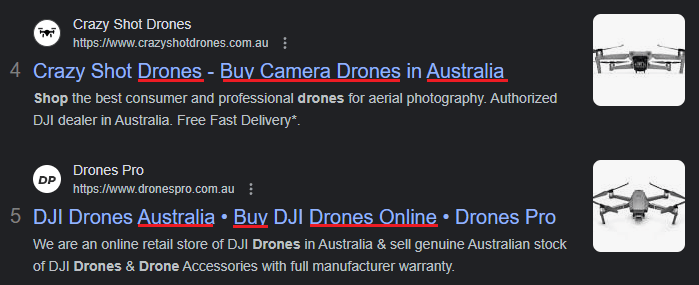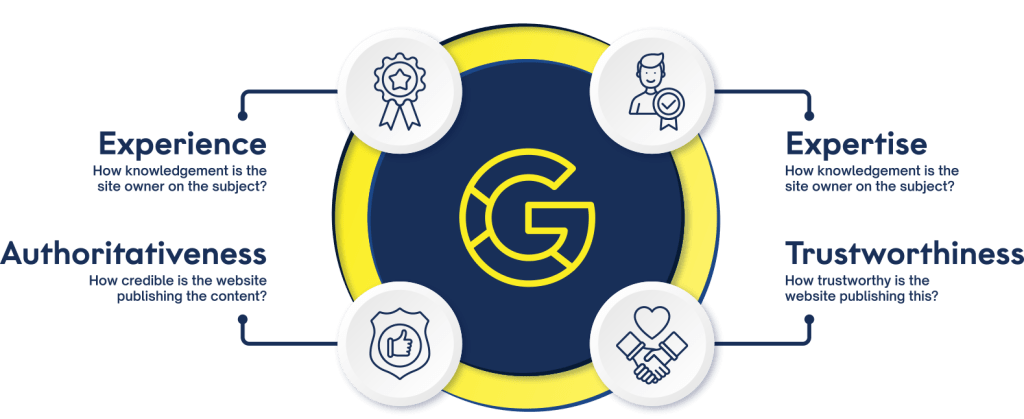Shopify is an excellent platform for new store owners, offering robust features and efficient SEO capabilities. While site speed, HTTPS enablement, and organized backend structures through Collections and Pages are inherent strengths, there’s always room for further optimization.
In this guide, I’ll go into depth on completing a Shopify SEO Audit and harnessing these strengths to maximize your store’s online visibility and success.
On-Site Optimization Techniques
The cornerstone of effective SEO is on-site optimization. This involves enhancing your website’s structure, content, and on-page elements like titles and meta descriptions to ensure search engines can easily interpret and rank your site. Pay special attention to your page titles; they should be concise, and unique, and incorporate relevant keywords without being redundant or overly lengthy.
Optimize your titles
Incorporating relevant keywords in your webpage titles is essential for effective SEO, as titles are a primary element that search engines evaluate. This strategy not only enhances your page’s relevance in search results but also improves its visibility to potential visitors.
For optimizing your homepage title for search engines, consider this approach:

Modifying all your page titles to include a descriptive keyword for each page is a strategic move in SEO. This practice ensures that every page is explicitly aligned with relevant search queries, thereby increasing the likelihood of appearing in search results.
When choosing keywords, it’s important to select terms that accurately reflect the content of the page, while also considering the search terms your target audience is likely to use. This approach not only aids in search engine optimization but also enhances the user experience by providing clear and concise titles that directly relate to the page content.
Meta Description Refinement
Meta descriptions act as a brief sales pitch to your potential customers. Craft them carefully to entice users, keeping within the 110-155 character limit. A well-written meta description can significantly improve click-through rates from search results.
Additionally, use the meta description as an opportunity to inject more keywords. You may notice that Google will often highlight related words/phrases in the meta description. Here’s an example:

Users will often introduce additional terms into their search queries. For example, someone searching for a new watch might add “silver” or “Swiss-made” to their search. As long as the page you’re optimizing includes those specific products, you should consider adding those terms to the meta description. Doing this will help you rank higher for more specific queries that are directly related to your website.
Remember, targeting more specific queries can be highly beneficial for conversion rates. When users refine their search queries with additional, specific terms, they demonstrate a clearer intent. For instance, a user searching for a ‘watch’ shows a general interest, but adding ‘silver’ or ‘Swiss-made’ indicates a more defined need or preference.
Don’t forget to add a call-to-action
Wherever possible, add a call-to-action to your meta description, as this will improve click-through rates. Here are some examples of call-to-actions you can add to the end of your meta descriptions:
- “Shop online now”
- “Discover your perfect style today”
- “Explore our exclusive range”
- “Start shopping now”
- “Browse our collection”
How to change meta titles and descriptions in Shopify
You might be wondering how to change the meta title and description for a page on your Shopify website. Follow Shopify’s guide on how to make those changes.
Add More Content To Your Store
The mantra in SEO is clear: Content is king. Yet, having numerous products or rich visual elements doesn’t necessarily translate to quality content. Google gives precedence to text that can be indexed. Ensure your homepage and crucial pages are embedded with comprehensive, pertinent text that matches the search queries you’re targeting.
- Avoid thin content pages: Many Shopify websites have a lack of content on them. Enriching your website with more content not only enhances the user experience but also offers more information for search engines to index. Continuously contribute meaningful, original content to your site, particularly in areas that lack coverage.
- Optimize the Homepage: The homepage typically represents the initial point of contact between customers and your brand. It’s advisable not to limit your homepage title to just the brand name. Instead, integrate it with pertinent keywords for a more influential title. Aim for a harmonious blend of brand identity and keyword optimization.
- Optimise Product Categories: Look for opportunities to add content to your product category pages. Provide more context to Google by adding 1-3 headings and a few paragraphs that describe the products within that category.
- Create Distinctive Product Descriptions: For your products to shine in search results, it’s vital to have unique product descriptions. This approach helps in evading issues of duplicate content and enhances your products’ visibility in search engines.
Remove any duplicate content
Duplicate content is a common problem on e-commerce websites and can be detrimental for several reasons, particularly in the context of search engine optimization (SEO). Here are the top reasons you need to find and fix duplicate content issues:
- Search Engine Rankings: Search engines like Google aim to present unique and diverse content to users. When there are multiple pages with substantially identical content, search engines struggle to decide which version is most relevant to a given search query. This can result in lower visibility and rankings for all the duplicated pages.
- User Experience: Duplicate content can create a confusing user experience. If users encounter multiple pages with the same content, it may be challenging for them to determine which is the most relevant or authoritative. This can negatively impact trust and engagement.
- Wasted Crawl Budget: Search engines allocate a certain amount of resources to crawl each site, known as a crawl budget. If a significant portion of a site’s content is duplicated, search engines might spend a considerable amount of this budget crawling and indexing multiple versions of the same content, potentially neglecting unique, valuable content elsewhere on the site.
- Penalties and Filters: While Google does not impose a penalty for duplicate content per se, it does filter out duplicate content in SERPs (Search Engine Result Pages). This means only one version of the content will show up in search results, which might not be the version you prefer.
- Keyword Cannibalization: If multiple pages of your website target the same or similar keywords, they can end up competing against each other in search engine results, a phenomenon known as keyword cannibalization. This can harm the ranking potential of both pages.
Finding Duplicate Content On Your Website:
Detecting and managing duplicate content on your eCommerce website involves a strategic approach. Here are some key areas and methods to look for duplicate content:
- Product Descriptions: This is a common area for duplication, especially if you’re selling products that are available on multiple sites. Each product should have a unique description.
- URL Parameters: Often, different URL parameters (like session IDs, tracking codes, or product filters) can create duplicate content. Check if multiple URLs lead to the same or similar content.
- WWW vs. Non-WWW and HTTP vs. HTTPS: Ensure that your website is accessible only through one version – either with or without “www” and securely via “HTTPS”. Having both accessible can lead to duplicate content issues.
- Pagination Issues: In eCommerce, pagination can create duplicate content if not handled correctly, especially in category pages.
- Similar Pages: Look for pages that are very similar in content but not exactly identical. This is common in category pages or product pages with slight variations.
- Content Across Domains: If you have multiple domains or subdomains, check for content that might be duplicated across these.
Tools and Methods to Identify Duplicate Content:
- Google Search Operators: Use Google search operators like “site:” to find indexed pages on your site. You can also search for specific phrases from your site in quotes to see if they appear elsewhere on the web.
- SEO Tools: Tools like Copyscape, Ahrefs, or Semrush can scan your site for duplicate content issues.
- Google Analytics: Look for pages with high bounce rates or low time on page, as these might be duplicates that don’t engage users.
- Google Search Console: This tool can help identify URL parameter issues and provide insights into how Google views your site’s structure.
- Crawling Software: Use website crawling tools like Screaming Frog SEO Spider to identify duplicate page titles, descriptions, and content on your site.
It’s important to regularly monitor and audit your site for duplicate content. Once identified, you can take steps like setting up 301 redirects, using canonical tags, or revising the content to ensure each page is unique and valuable to both users and search engines.
Leveraging Shopify’s Built-in SEO Tools
Shopify provides several built-in tools to aid in your efforts. Utilize these to optimize headers, titles, and meta tags effectively. Remember, these tools are designed to streamline your process, providing a solid foundation for your overall strategy.
Incorporate E-E-A-T Into Your Shopify Store

It’s important to show Google that your website meets their E-E-A-T Guidelines. For an e-commerce website to effectively embody the principles of E-E-A-T (Experience, Expertise, Authoritativeness, and Trustworthiness), several key elements should be incorporated:
Demonstrating Experience
- Customer Testimonials and Reviews: Display real customer experiences, reviews, and testimonials to provide social proof of your product’s value and your brand’s reliability.
- Case Studies: Showcase how your products have solved problems or improved situations for customers.
- Background Information: Provide details about your company’s history, the founders, and the team to humanize your brand and demonstrate accumulated experience.
Exhibiting Expertise
- Detailed Product Information: Offer comprehensive, accurate, and useful product descriptions that demonstrate your knowledge of the products.
- Educational Content: Publish well-researched blog posts, guides, and how-to articles related to your products or industry.
- Credentials and Qualifications: Highlight the qualifications, certifications, or awards that you or your team have received in your field.
Building Authoritativeness
- Press Mentions and Industry Recognition: Feature any mentions in reputable publications or achievements in the industry to bolster credibility.
- Influencer Collaborations: Partner with industry influencers or experts to leverage their authority and enhance your brand’s standing.
- High-Quality Backlinks: Earn backlinks from authoritative and relevant websites to signal to search engines that your site is a respected source of information.
Establishing Trustworthiness
- Secure Website: Ensure your website uses HTTPS to protect user data and transactions, boosting confidence in your site’s security.
- Transparent Policies: Clearly display privacy policies, terms of service, return and shipping policies, and any guarantees to build trust.
- Contact Information: Provide easy-to-find contact details, including physical address, phone numbers, and email, to show that you are a legitimate and accessible business.
- User-Friendly Interface: Offer a clean, easy-to-navigate website design, enhancing the user experience and demonstrating professionalism.
- Customer Service Excellence: Provide exceptional customer service, including easy returns, responsive support, and user-friendly assistance.
Complete A Technical Audit Of Your Shopify Site
Site Speed
Site speed is crucial for both user experience and search engine rankings. Slow loading times can lead to higher bounce rates and lower user engagement, negatively impacting SEO. Optimization strategies include:
- Image compression to reduce file sizes without compromising quality.
- Implementing caching, which stores copies of files so they load faster upon subsequent visits.
- Minimizing JavaScript and CSS files.
- Using a Content Delivery Network (CDN) to speed up content delivery.
You can use Google’s PageSpeed Insights tool to scan your website’s performance and see if any improvements need to be made.
Mobile Responsiveness
With the majority of web traffic now coming from mobile devices, having a mobile-responsive site is essential. Google’s mobile-first indexing means that Google predominantly uses the mobile version of content for indexing and ranking. To optimize for mobile, ensure:
- Responsive web design that adapts to various screen sizes.
- Fast loading times on mobile.
- Easy-to-use navigation and accessible content on smaller screens.
You can use Google’s Mobile Friendliness Test to determine if Google thinks your website is mobile friendly.
SSL/HTTPS
Secure Sockets Layer (SSL) and HTTPS (the secure version of HTTP) are vital for website security and user trust. Google has confirmed that HTTPS is a ranking factor. To secure a site with HTTPS:
- Make sure your Shopify website has an SSL Certificate.
- Update the website to ensure all resources are loaded over HTTPS.
- Set up 301 redirects from HTTP to HTTPS versions of your web pages.
URL Structure
SEO-friendly URLs are concise, easy to read, and include relevant keywords. Best practices include:
- Keeping URLs short and descriptive.
- Using hyphens (-) instead of underscores (_) to separate words.
- Avoiding excessive use of parameters and numbers.
Site Architecture
A well-structured website helps users and search engines navigate your content efficiently. This includes:
- A logical hierarchy in site navigation.
- Including a sitemap.xml file for search engines.
- Internal linking that supports the site’s structure.
Crawl Errors and Canonical Tags
Use Google Search Console to identify and fix crawl errors. Canonical tags are used to manage duplicate content, telling search engines which version of a similar page to prioritize.
Off-Page Optimization
What Are Backlinks? Backlinks are hyperlinks from other websites that direct users to your site. They are essentially references or citations from one website to another. When a reputable website links to your content, it signals to search engines that your content is valuable and trustworthy.
Why Are Backlinks Important?
- Authority and Trust: Backlinks from reputable sites act as endorsements for your content. When authoritative websites link to your pages, search engines view your site as a credible source of information. This can positively impact your site’s authority and trustworthiness in the eyes of search engines and users.
- Traffic Generation: Backlinks can drive direct traffic to your website. When users click on a backlink from another site, they land on your pages, potentially becoming new visitors or customers.
- Improved Search Engine Rankings: Search engines like Google consider the quantity and quality of backlinks when ranking websites. Websites with a strong backlink profile tend to rank higher in search results, leading to increased organic traffic.
However, it’s crucial to focus on building quality backlinks. Quality matters more than quantity. Backlinks from authoritative websites relevant to your industry carry more weight than numerous links from low-quality sources. Avoid using black-hat tactics like buying links or participating in link schemes, as search engines penalize such practices.
More on backlinks:
- Three Ways to Build Links That Won’t Cause Any Trouble with Google
- How to Get Started Building Backlinks with Infographics to Boost Your SEO Rankings
Local SEO For eCommerce Websites
Many Shopify stores can significantly benefit from optimizing for local SEO. Here are some quick tips on how you can improve your website’s local search engine rankings.
- Google My Business Optimization: Claim and optimize your Google My Business listing with accurate information, high-quality images, and regular updates.
- Local Citations and NAP Consistency: Ensure your business’s name, address, and phone number (NAP) are consistently listed across the web. Local citations on directories and listings can improve local search visibility.
- Local Reviews and Engagement: Encourage customer reviews and respond professionally to both positive and negative reviews. This can improve your visibility in local search results.
- Localized Content Creation: Develop content relevant to your local audience, including local keywords and topics of local interest.
User Experience (UX)
We now know that User Experience is extremely important for SEO, and is one of Google’s three core pillars of search rankings. For that reason, you should never overlook UX, and try your best to optimize for it in these key ways:
- Site Navigation and Usability: Ensure your site is easy to navigate with a clear menu structure and prominent calls-to-action (CTAs). Reduce user frustration by improving the usability of your site.
- Mobile User Experience: Focus on mobile optimization, considering factors like responsive design, touch-friendly interfaces, and mobile page speed.
- Engagement Metrics: Pay attention to metrics like bounce rate and dwell time, as they can indicate user satisfaction and impact SEO.
- Content Accessibility: Ensure your content is accessible to all users, including those with disabilities. This includes readable fonts, logical content layout, and the use of multimedia.
Create A Content Strategy For Your Brand
Is there a blog on your Shopify store? Establishing a blog provides you with the opportunity to generate content tailored to various search queries.
For example, if your eCommerce store specializes in hair care products, the blog on “hair color trends” can not only discuss the latest trends but also recommend products that are relevant to achieving those trends. By providing valuable information and subtly promoting your offerings, you can potentially convert these readers into customers. This is a powerful way to not only drive traffic but also boost conversions and grow your business.
Not sure where to start? Here are some topics to look into when starting a blog for your business:
- Identifying Target Audience and Intent: Understand who your audience is and what they are searching for. This helps in creating content that meets their needs and search intent.
- Keyword Research: Conduct thorough keyword research to understand the terms and phrases your audience uses. Incorporate these naturally into your content.
- Diverse Content Types: Utilize a variety of content types, like blogs, videos, and infographics, to engage different segments
Take Advantage Of Google’s Rich Results
What are Rich Results?
Rich Results, formerly known as Rich Snippets, are enhanced search results displayed by Google. They provide more detailed information than standard search listings, often including images, ratings, prices, and other useful data. These visually appealing results can improve your store’s visibility, encourage higher click-through rates, and provide potential customers with valuable information at a glance.
Rich Results are powered by Structured Data (Schema). Shopify automatically added Product Schema to your website for you, but you can add additional schema to take advantage of additional rich snippet features.
Here’s an example of an e-commerce website implementing Review Schema, which will make a star rating appear in Google search results.

We can also see images from their website appearing in the search results. While there’s no guaranteed method for ensuring these images appear, optimizing images in the Shopify backend increases the likelihood of Google displaying them for your site.
Implementing Rich Results in Shopify
- Structured Data: The foundation of Rich Results is structured data, a standardized format for providing information about a page and classifying the page content. This can include product details, prices, availability, reviews, and more for Shopify stores.
- Using Shopify’s Built-In SEO Features: Shopify platforms typically include built-in features for adding structured data to your product pages. This can be a straightforward way to start leveraging the benefits of Rich Results.
- Google’s Structured Data Testing Tool: Use this tool to test your structured data implementation. It helps you identify any issues that need to be fixed to ensure your structured data is correctly set up for Rich Results.
- Types of Rich Results for eCommerce:
- Product Rich Results: Display pricing, availability, and review ratings directly in search results.
- FAQ Rich Results: Show frequently asked questions and answers on your product pages.
- Breadcrumb Rich Results: Provide a clear breadcrumb list that helps users understand and navigate your website’s structure.
- Monitoring Performance: Use Google Search Console to track your Rich Results performance. This tool provides insights into how often your rich results appear in searches, click-through rates, and other valuable metrics.
- Staying Updated with Google’s Guidelines: Google frequently updates its guidelines and requirements for Rich Results. Regularly reviewing these updates is crucial to ensure your Shopify store continues to comply and make the most out of these features.
Best Practices for Optimizing Rich Results
- Accuracy and Completeness: Ensure all structured data is accurate and provides a complete picture of your product or page. Inaccurate or misleading information can lead to penalties from Google.
- High-Quality Images: Use clear, high-resolution images for your products, as these may be displayed in Rich Results.
- Encourage Customer Reviews: Positive reviews can be a part of your Rich Results, enhancing the trust and attractiveness of your listings.
- Mobile Responsiveness: As Rich Results are increasingly displayed on mobile devices, ensure your Shopify store is fully responsive and mobile-friendly.
Tracking and Reporting
The importance of tracking and analyzing your efforts to measure success and identify areas for improvement cannot be overstated. We highly recommend setting up Google Analytics and using it to gain insight into your marketing strategy.
Further Reading: The Next Generation of Analytics: A Comprehensive Guide to Google Analytics 4
The Importance of Regular Shopify SEO Audits
One effective way to ensure your Shopify store remains competitive is by conducting regular SEO audits. While it might sound like a daunting task, these audits are essential for several reasons:
1. Stay Up-to-Date with Algorithm Changes: Search engines like Google frequently update their algorithms. These changes can impact your site’s ranking and visibility. By conducting regular audits, you can identify any issues caused by algorithm updates and make necessary adjustments promptly.
2. Monitor Keyword Performance: Keywords are the foundation of SEO. Over time, search trends and customer preferences can change. Regular audits allow you to track the performance of your chosen keywords. Are they still relevant and effective in driving traffic to your site? If not, it’s time to update your keyword strategy.
3. Identify Technical Issues: Technical SEO issues can hamper your site’s performance. These issues might include broken links, slow page loading times, or mobile responsiveness problems. Regular audits help you catch and address these technical issues before they negatively impact your user experience and search engine rankings.
4. Improve User Experience: User experience is a critical factor. Ensuring your website is easy to navigate, loads quickly, and provides valuable content is essential. Regular audits can reveal areas where your site can be enhanced to improve user satisfaction and engagement.
5. Optimize Content: Content is king in the digital world. Regular audits allow you to assess the quality and relevance of your content. Are your blog posts up to date? Are product descriptions optimized for SEO? Identifying content gaps and making improvements can boost your site’s overall performance.
6. Stay Competitive: Your competitors are likely also investing in SEO efforts. Regular audits can help you gauge where you stand in comparison to them. Analyzing their strategies and performance can give you insights into areas where you can outperform them.
7. Maximize ROI: SEO can be a significant investment in time and resources. Regular audits ensure you get the most out of your SEO efforts. You can allocate your resources more effectively by focusing on strategies and tactics that deliver the best results.
Get A Free SEO Audit For Your Shopify Website
Do you need help with your SEO? Unlock the full potential of your website with a Free SEO Audit conducted by the seasoned experts at Digital Eagles. Our comprehensive analysis will provide valuable insights into your current SEO performance and uncover opportunities for improvement. Take the first step towards optimizing your online presence today.
If you’re eager to enhance your Shopify SEO strategy and need assistance, our team is just a message away and ready to help!
Contact us today!



















